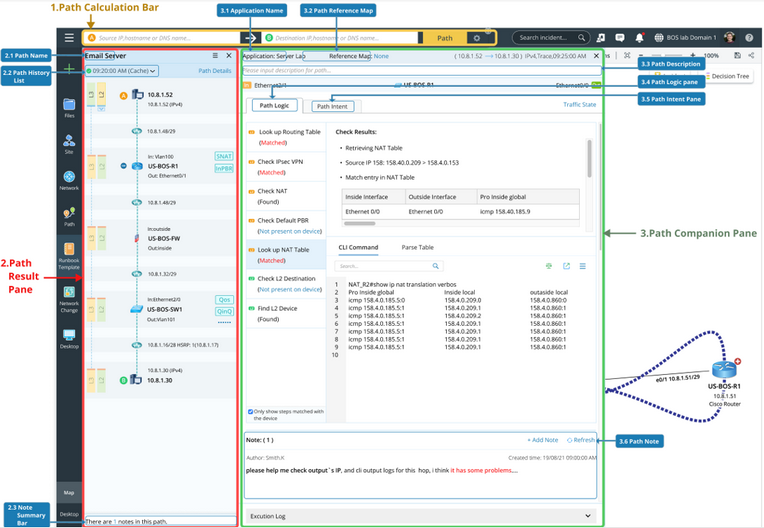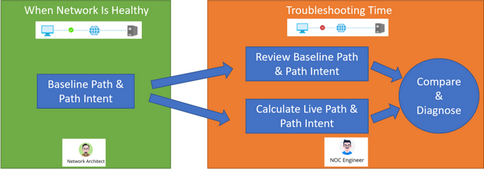Using A-B Path to Analyze Network Traffic
Unlike traditional traffic path tools, NetBrain Dynamic Path Calculator visualizes the forwarding of packets and emulates the real packet forwarding process in your live network (including overlay and underlay networks). It also enables you to baseline, document, and define the diagnosis logic for the application path efficiently when the network is healthy. Then this well-documented and executable knowledge can help you resolve application slowness issues more efficiently and do effective application impact analysis efficiently when a problem occurs on a network device or device interface.

Visualization and Monitor Abilities:
Path-Based Troubleshooting Flow: the Path Intent feature and Intent-based new Trigger Automation Framework(TAF) and a few other Path-related function enhancements, together enable users to baseline, document, and define the diagnosis logic for application path efficiently when the network is healthy, and then these well-documented & executable knowledge can help network engineers resolve application slowness issue much more efficiently during troubleshooting, or do effective application impact analysis efficiently when some issues occurred on a network device or device interface.
Path-based Troubleshooting Flow
1.Baseline Path and Path Intent, Add Path Intent into Intent Cluster (when the network is healthy)
When a network is healthy, the critical application flows can now be calculated via live network data with full documentation behind the path logic, and path-related baseline data and diagnosis logic can be programmatically defined inside path Intent without any coding. Add predefined Path Intents into a NIC as static member intents. Define trigger diagnosis using the NIC and define the NIC filter condition with path source/destination properly.
2.Trigger Path-Based Diagnosis (during troubleshooting)
TAF receives the ticket sent by the third party and triggers the execution of NIC according to the logic defined in TAF.NIC executes its associated member NI according to the defined logic. For path, all the main path NIs need to be associated with the corresponding NIC. Path NI executes according to the logic defined in NIC and then sends the alert message to the Incident pane.
3.Review Baseline Path and Path Intent (during troubleshooting)
During troubleshooting time, the pre-documented application path can be intuitively accessed via the A|B path dialog by any network troubleshooter. The pre-documented path results along with the pre-built diagnosis automation will accelerate the slow application troubleshooting.
4.Calculate Live Path and Compare with Cached Path (during troubleshooting)
During troubleshooting, users can re-calculate live paths, and compare paths between live and cached data to reveal various issues behind a slow application.
5.Execute Path Intent and Diagnose Issues (during troubleshooting)
The associated path intent can be re-calculated via live network, then user can check the intent diagnosis results directly.
The following topics are covered in this chapter:
▪Mapping an End-to-End Traffic Flow with Path Calculator
▪Managing Paths in Path Browser
▪Running Qapps to Monitor a Path
▪Path Technologies for Different Vendor
▪Predefining Gateways for Path Calculation
▪Path-Based Troubleshooting Use Flow



